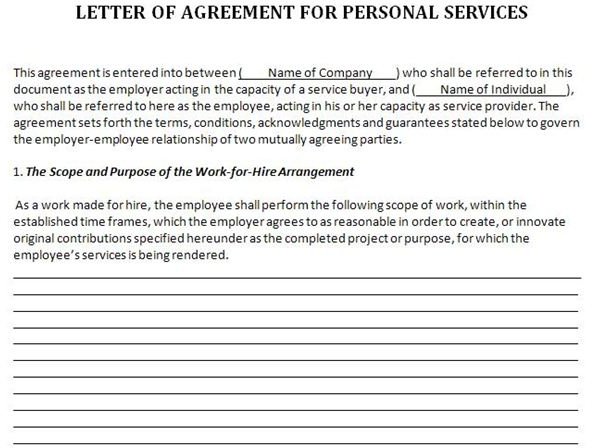Explaining the Work-for-Hire Doctrine in Employment
The Exception to the Copyright Rule
This concept is referred to in the 1976 Copyright Act as “work made for hire” and defined under Section 101 as “work that is prepared by an employee within the scope of his or her employment”. Although the term copyright generally applies to the advantage of the creator or the author to claim sole ownership rights from his original work and all that will be derived from it, this type of work is the exception to the copyright rule.
An applicant who successfully lands a job as a graphic designer, as a computer programmer, as a comic strip illustrator or other similar occupation, for which the acceptance of employment is based on one’s exceptional skills and talent, produces work that is made for hire. The right of ownership over the new hire’s creative work and all the benefits that will be derived from it become the property of the employer.
The section further states nine categories for which a contribution is being commissioned as a job. The contributions include a:
- Collective work.
- Component of a motion picture.
- Part of an audiovisual set-up.
- Translated work.
- Supplemental accomplishment.
- Compilation of varying substances.
- Set of instructional guidelines.
- Set of test answers for a particular examination material.
- Chart, diagram or an atlas.
Determining the Employer-Employee Relationship

A 1989 Supreme Court decision provided the groundwork on which work-for-hire (WFH) is established. That groundwork is whether the creator agreed to contribute as an employee or as an independent contractor.
The Innovator as an Employee
An employee who performs work in his capacity as originator or innovator for any of the aforementioned categories or similar works is technically providing services under the “agency theory.” The latter is defined as a business, entity or actor who intervenes to facilitate the creation or production of a particular result or effect.
The employee here is being selected on the basis of his ability to provide a particular creative service in accordance with the specifications or preferences of the hirer. This stands opposed to a regular employee whose skills or talents are being applied for a generic field or purpose.
In a work-for-hire arrangement, the employer can add his or her own input so that results will reflect the business image or brand in order to serve an intended purpose. Thus the created outcome will be identified or associated with the employer’s business.
Whereas the work of an independent contractor carries the innovator’s own style or distinction, it adds value to the outcome of the work performed. The contracted work provided is only for the viability of the product, which in this case is deemed by the service buyer as suitable for his purpose. Normally, the produced outcome will still carry the independent contractor’s brand or registered trade name.
The Employer Becomes the Official Innovator
The hirer as employer has control over the outcome of the innovator-employee’s work. The employer may approve or disapprove the creation or may ask the innovator-employee to incorporate ideas based on the employer’s own standards of what is lucrative for the business.
This is by virtue of the employer’s greater contribution as the capitalist, since he provides the venue, the materials, the utilities, the equipment, the additional workforce and the marketing tools.
These premises establish the fact that in an employer-employee relationship, the employer becomes the official copyright holder of the original creation.
The WFH Agreement Letter
Despite all the definitions, deliberations and distinctions, certain disputes regarding jobs contracted on a for-hire basis still crop up. This happens so frequently that best practices recommend adopting a “Work-for-Hire Agreement Letter” in place of or in addition to a job contract.

1. The Title of the Agreement
The title should clearly define that the work agreement being entered into is “for personal services.” The definition of the term “personal service” is the provider’s actual delivery of a viable performance by way of one’s manual or intellectual capability, for the primary purpose of creating a document or item, to be used by the person or entity who has agreed to pay remuneration.
2. The Parties to the Agreement
The parties are identified as the employer, who is also the service buyer and agrees to enter into an agreement with the service-provider, who is the other party named in the document as the employee.
3. The Scope and Purpose of the WFH Arrangement
An outline of the scope of work shall be indicated, including the duties and responsibilities to be performed by the employee as service provider and a description of the completed work as the primary purpose for rendering the services.
4. The Tenure or Duration of the WFH Agreement
An agreement usually covers a one-year period and with annual renewal, unless any of the parties to the agreement decides not to accept another term of renewal. In that case the disengaging party shall give 30 days’ due notice before the term of the agreement ends.
5. The Remuneration or Service Fees
This section shall embody the amount of compensation that the employer will pay the employee based on a specific pay rate as well as the definite periods of interval or the exact date by which the payment will be received by the latter. The information shall include the amount of the federal and statutory taxes to be withheld as mandated by the related laws.
If it has been previously agreed upon by both parties to include certain benefits extended by the employer to its regular employees, the information should likewise be incorporated in this section. It should state the specific date that the benefits will take effect and will inure in favor of the employee; plus it should also state any other conditions that should be met by the employee in order to be eligible for this benefit.
6. Cost of Supplies and Materials
There should also be a statement to the effect that the cost of materials to be used shall be for the account of the employer. The arrangement for its purchase should in no way be the cause of delay for the project’s or the objective’s completion. This denotes that any of the parties may facilitate the purchase of the materials required if it will facilitate the performance of the work according to scope’s schedule.
7. Acknowledgments and Guarantees
-
The employee acknowledges that he or she fully understands the employer’s requirements and specifications and will seek the latter’s confirmation that the work-in-progress is proceeding according to specifications.
-
The employee expressly guarantees that work shall be completed on the specific deadlines given by the employer for every project assigned, which makes it necessary to state the reasonable time for each project to be completed.
-
The employee acknowledges the employer’s right to rescind their agreement in the event that he or she fails to deliver the goods or items on the specific deadlines or according to the specifications set by the employer.
-
The employee shall also acknowledge that the completed work produced by the services rendered shall become the property of the employer. He further acknowledges the transfer of copyright privileges from the employee to the employer as the rightful and official holder of all related copyrights.
-
The employee agrees to surrender all documents, manuscripts, drafts and materials related to the completed work in the event that the agreement will be terminated. He further holds himself committed to all ethical standards governing business agreements, particularly those that pertain to matters of confidentiality regarding the employer’s business.
-
The employer shall acknowledge the condition that any failure to pay the employee the remuneration agreed upon as embodied in this document will likewise constitute a failure in the transfer of copyright ownership for the completed work. This denotes that all rights to the object or item created shall stay with the employee as the creator or the originator.
-
The employer will likewise agree to monitor the work in progress and give his confirmation that the work is being fulfilled according to his specifications. Any failure on the part of the employer to monitor the work-in-progress will forfeit his rights to rescind the contract based on the employee’s failure to meet the specifications.
-
The employer guarantees payment of all pending remunerations prior to his decision to rescind the contract on valid grounds.
-
The signing of both parties to the agreement constitutes their acknowledgment that the work made for hire agreement is governed by the prevailing federal and statutory laws and the agreement has been entered into for purposes of performing legal works. The signing also signifies that both parties understood the terms and conditions surrounding the agreement, which for all intents and purposes is for their mutual benefit.
Downloadable Sample of a WFH Agreement Letter
A downloadable copy of the sample “Work for Hire Agreement Letter” as presented above is available at Bright Hub’s Media Gallery. The sample is intended for purposes of illustrating its contents, which can be modified to suit a user’s own business purpose. The author, however, does not guarantee that the sample can withstand any legal assertions or tests, in the event that a dispute arises between the employer-service buyer and the employee-service provider.
Reference Materials and Image Credit Section:
References:
- Works Made for Hire Under the 1976 Copyright Act – https://www.copyright.gov/circs/circ09.pdf
- Personal Services - https://legal-dictionary.thefreedictionary.com/personal+services
Image Credit Section:
- Both “copyright images” were released under Creative Commons Attribution/Share-Alike License / Wikimedia Commons
- Screenshot image of Work-for-hire Agreement Letter" was created for this article by the author.
